 W
WThe Aberdeen Bestiary is a 12th-century English illuminated manuscript bestiary that was first listed in 1542 in the inventory of the Old Royal Library at the Palace of Westminster. Due to similarities, it is often considered to be the "sister" manuscript of the Ashmole Bestiary. The connection between the ancient Greek didactic text Physiologus and similar bestiary manuscripts is also often noted. Information about the manuscripts origins and patrons are circumstantial, although the manuscript most likely originated from the 13th century and was owned by a wealthy ecclesiastical patron from north or south England. Currently, the Aberdeen Bestiary resides in the Aberdeen Library in Scotland.
 W
WThe Apocalypse of Lorvão is an illuminated manuscript from Lorvão, Portugal containing the Commentary on the Apocalypse of Beatus of Liébana Monastery, Spain.
 W
WThe Bichvinta Four Gospels is a 12th-century illuminated manuscript of the Four Gospels in Georgian, copied in the nuskhuri script. It is named after the cathedral church in Abkhazia, where the book was discovered in 1830. The manuscript is now at the Georgian National Center of Manuscripts, Tbilisi, as H-2120.
 W
WThe Book of Leinster, is a medieval Irish manuscript compiled c. 1160 and now kept in Trinity College, Dublin, under the shelfmark MS H 2.18. It was formerly known as the Lebor na Nuachongbála "Book of Nuachongbáil", a monastic site known today as Oughaval.
 W
WThe Cîteaux Moralia in Job is an illuminated copy of Gregory the Great's Moralia in Job made at the reform monastery of Cîteaux in Burgundy around 1111. It is one of the most familiar but least understood illuminated manuscripts of the Middle Ages. The manuscript is housed at the municipal library in Dijon.
 W
WDe balneis Puteolanis is a medieval didactic poem in Latin, attributed to Peter of Eboli, describing the thermal baths of Pozzuoli in the Campi Flegrei region of Campania. The poem has the alternative title De balneis terrae laboris.
 W
WEvangeliary of Averbode is an illuminated manuscript evangeliary with typological illustrations. It was created in the Meuse Region of Belgium, and is an example of Romanesque Mosan art.
 W
WFragmenta Vindobonensia, also known as the Vienna folios, is the name of two illuminated Glagolitic folios that most likely originate from 11th- or 12th-century Croatia and Dalmatia. They were discovered and first described by Vatroslav Jagić in 1890 and are kept in the National Library in Vienna. Some research puts their origin in western Croatia.
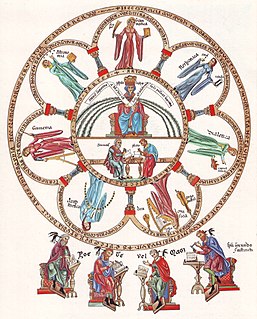 W
WHortus deliciarum is a medieval manuscript compiled by Herrad of Landsberg at the Hohenburg Abbey in Alsace, better known today as Mont Sainte-Odile. It was an illuminated encyclopedia, begun in 1167 as a pedagogical tool for young novices at the convent. It is the first encyclopedia that was evidently written by a woman. It was finished in 1185, and was one of the most celebrated illuminated manuscripts of the period. The majority of the work is in Latin, with glosses in German.
 W
WThe Lambeth Bible is a 12th-century illuminated manuscript, among the finest surviving giant Bibles from Romanesque England. It exists in two volumes; the first is in Lambeth Palace Library and covers Genesis to Job on 328 leaves of vellum measuring circa 520 x 355 mm; the second incomplete volume is in the Maidstone Museum & Art Gallery.
 W
WThe Liber ad honorem Augusti sive de rebus Siculis is an illustrated narrative epic in Latin elegiac couplets, written in Palermo in 1196 by Peter of Eboli. The presentation copy, ordered by chancellor Conrad of Querfurt, is now MS. 120 II of the Berne Municipal Library.
 W
WLiber daticus vetustior is a 12th-century illuminated manuscript probably made in Lund. It was made to serve as the martyrology and obituary of the canons of Lund Cathedral.
 W
WThe Liber feudorum maior, originally called the Liber domini regis, is a late twelfth-century illuminated cartulary of the Crown of Aragon. It was compiled by the royal archivist Ramon de Caldes with the help of Guillem de Bassa for Alfonso II, beginning in 1192. It contained 902 documents dating as far back as the tenth century. It is profusely illustrated in a Romanesque style, a rarity for utilitarian documents. The LFM is an indispensable source for the institutional history of the emerging Principality of Catalonia. It is preserved as a file in the Arxiu de la Corona d'Aragó (ACA), Cancelleria reial, Registres no. 1, in Barcelona.
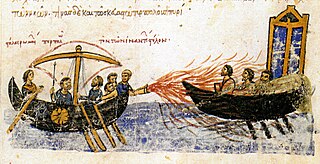 W
WThe Madrid Skylitzes is a richly illustrated illuminated manuscript of the Synopsis of Histories, by John Skylitzes, which covers the reigns of the Byzantine emperors from the death of Nicephorus I in 811 to the deposition of Michael VI in 1057. The manuscript was produced in Sicily in the 12th century, and is now at the Biblioteca Nacional de España in Madrid, with the shelfmark MS Graecus Vitr. 26–2. Other names for it include the Latin: Codex Græcus Matritensis Ioannis Skyllitzes, or Skyllitzes Matritensis.
 W
WCodex Basilensis A. N. IV. 2, Minuscule 1, δ 254 and formerly designated by 1eap to distinguish it from minuscule 1rK is a Greek minuscule manuscript of the New Testament, usually dated palaeographically to the 12th century AD. It is written on 297 parchment leaves and contains the entire New Testament except the Book of Revelation.
 W
WCodex Basiliensis A. N. IV. 1, known as Minuscule 2, ε 1214, is a Greek minuscule manuscript of the New Testament, dated palaeographically to the 11th or 12th century. It was used by Erasmus in his edition of Greek text of the New Testament and became the basis for the Textus Receptus in the Gospels. The manuscript has complex contents.
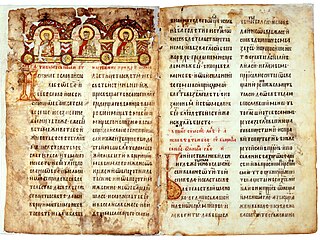 W
WMiroslav's Gospel is a 362-page illuminated manuscript Gospel Book on parchment with very rich decorations. It is one of the oldest surviving documents written in the Serbian recension of Church Slavonic. The gospel is considered a masterpiece of illustration and calligraphy.
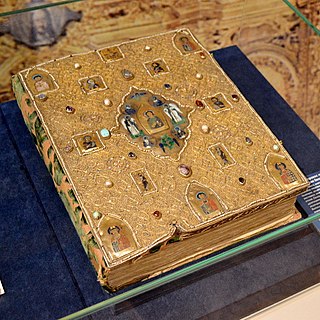 W
WMstislav Gospel is a 12th-century manuscript of the four Gospels on parchment in Old Church Slavonic. It is kept in the State Historical Museum in Moscow. The manuscript contains the text of the four Gospels on 213 parchment leaves.
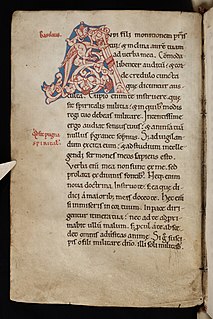 W
WNecrologium Lundense is a 12th-century illuminated manuscript probably made in Lund to serve as a book of rules for the canons of Lund Cathedral, with texts used by them in their daily life. Its oldest parts date from around 1123, and it is considered the oldest still intact manuscript written in Scandinavia. It is preserved in a late medieval binding and the text is partially adorned with decorated initials, including one which displays influences from Viking art. The book is today kept in the University Library of Lund University.
 W
WThe volume NLW MS 735C comprises several Latin texts on astronomy that were copied c. 1000 to c. 1150. Thus, it is the oldest scientific manuscript in the National Library of Wales. It contains a description of the constellations in Germanicus' Latin translation of the Greek Phaenomena by Aratus, with illustrations that demonstrate the interrelatedness of myth, astronomy and astrology during the period around 1000, when this section of the manuscript was created in the Limoges area. The second section of the manuscript was completed by a scriptorium in the same part of France c. 1150.
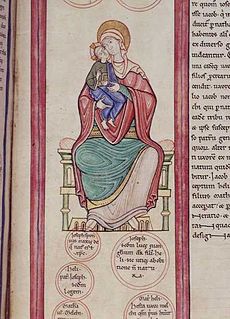 W
WThe Parc Abbey Bible is a 12th-century illuminated Bible. It was made in the Leuven region of Belgium at the Abbey of St. Mary of Parc. A colophon on folio 197 indicates that the codex was produced in 1148. The text is Latin and written in proto-gothic book script on vellum. The folios are 437 by 300 mm, with the text block being 340 by 240 mm. The manuscript is illuminated with miniatures, diagrams, decorated borders, and decorated initials. The decorated initials include historiated, inhabited, and foliate initials.
 W
WThe Skara Missal is a 12th-century illuminated manuscript, a missal kept in Stifts- och landsbiblioteket i Skara, a library in Skara, Sweden. It is the oldest surviving missal of this kind in Scandinavia. It is written in Latin, and is in folio format. Only about one eighth of the original remains, or 44 pages. The book was originally bound in a single volume, but is since the 13th or 14th century split into two volumes. One of the volumes is currently part of the permanent exhibition of Västergötland Museum. It was written by two different scribes. It contains text, illuminations and musical notes. The illuminations consist of two full page illustrations, four large decorative initials and a number of smaller ones. Certain traits indicate that the illuminator may have come from Scandinavia.
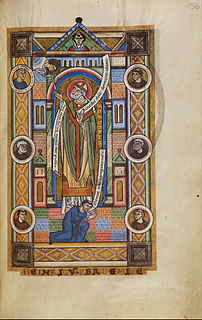 W
WThe Stammheim Missal is an illuminated manuscript Roman missal now in the J. Paul Getty Museum, which bought it from the barons of Fürstenberg's private collection; they sold it to raise funds to repair Schloss Körtlinghausen. A Carolingian ivory diptych had been used on or for its binding, but was taken off in 1904 and was in the State Museums of Berlin, where it disappeared during the museum's bombing in 1945.
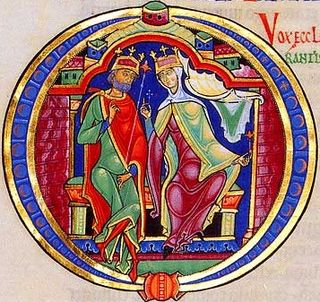 W
WThe Winchester Bible is a Romanesque illuminated manuscript produced in Winchester between 1150 and 1175 for the Winchester Cathedral. With folios measuring 583 x 396 mm., it is the largest surviving 12th-century English Bible. The Winchester Bible is an important to understanding the history of medieval art, because it was left only partially completed, giving insight into the creation and production of these kinds of Bibles. It can still be seen at the Winchester Cathedral Library, which has been its home for more than eight hundred years. Before it was returned to the Winchester Cathedral, the Bible had many owners and suffered because of it. Pages have been removed and torn out; one of those pages is known as the Morgan Leaf and is owned by the Morgan Library.
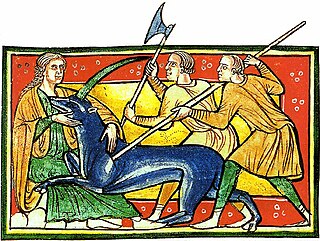 W
WThe Worksop Bestiary, also known as the Morgan Bestiary, most likely from Lincoln or York, England, is an illuminated manuscript created around 1185, containing a bestiary and other compiled medieval Latin texts on natural history. The manuscript has influenced many other bestiaries throughout the medieval world and is possibly part of the same group as the Aberdeen Bestiary, Alnwick Bestiary, St.Petersburg Bestiary, and other similar Bestiaries. Now residing in the Morgan Library & Museum in New York, the manuscript has had a long history of church, royal, government, and scholarly ownership.